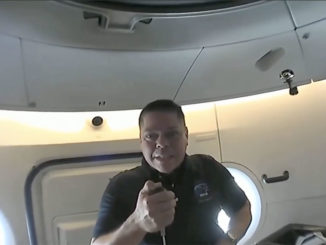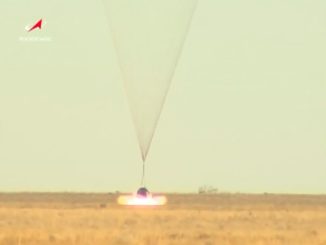STORY WRITTEN FOR CBS NEWS & USED WITH PERMISSION

Two spacewalking astronauts working outside the International Space Station Friday completed work to replace aging batteries in one of the lab’s eight main solar power circuits. A second spacewalk next week, along with additional work with the station’s robot arm, will upgrade a second power channel.
Expedition 50 commander Shane Kimbrough and flight engineer Peggy Whitson — at 56, the oldest woman to fly in space and one of NASA’s most experienced spacewalkers — began the six-hour 32-minute excursion at 7:23 a.m. EST (GMT-5), leaving the Quest airlock and making their way to the right side of the station’s main solar power truss.
Each of the station’s four main sets of arrays, two on each end of the truss, provide power to two electrical buses, or channels. To keep the lab operating during passes through Earth’s shadow, each set of arrays is equipped with 12 massive nickel-hydrogen batteries, six per power channel.
All together, 48 NiH2 batteries store power for the station’s eight electrical channels. NASA is in the process of replacing all 48 with 24 smaller, more efficient lithium-ion power packs, a complex task that will take several years to complete,
The work began on New Year’s Eve when flight controllers at NASA’s Johnson Space enter in Houston remotely operated the station’s arm to begin removing the old NiH2 batteries from the electronics assembly at the base of the inboard starboard 4, or S4, set of solar arrays.
By the time Kimbrough and Whitson began their spacewalk Friday, all three lithium-ion batteries needed by S4 power channel 3A had been replaced and three of the older NiH2 batteries had been moved to a nearby pallet.
Kimbrough and Whitson then installed three so-called adapter plates in the S4 channel 3A electronics assembly and connected them to the new Li-ion batteries to maintain the circuitry originally used by pairs of NiH2 batteries wired in series. They also removed two more NiH2 batteries and mounted them on two of the adapter plates where they will remain in long-term storage.
The spacewalkers completed their tasks an hour or so ahead of schedule, so flight controllers asked them to carry out three “get-ahead” tasks.
Kimbrough carried out a photo survey of a high-energy physics experiment known as the Alpha Magnetic Spectrometer to help troubleshooters resolve a cooling issue and then helped Whitson retrieve a failed external light that will be replaced later.
The astronauts also routed an ethernet cable as a get-ahead and Whitson stored a set of micrometeoroid shields outside the Quest airlock as originally planned. The shields will be installed during a future spacewalk.
The astronauts returned to Quest, closed the hatch and began repressurization at 1:55 p.m., officially bringing the spacewalk to an end.
It was the 196th EVA devoted to space station assembly and maintenance since construction began in 1998, the third for Kimbrough and the seventh for Whitson. Total station spacewalk time now stands at 1,224 hours and six minutes, or 51 days.
Whitson’s total through seven EVAs over three fights stands at 46 hours and 18 minutes, moving her up to 14th on the list of most experienced spacewalkers.
Next week, the battery replacement work will continue with the S4 channel 1A upgrade.
Robot arm operators in Houston will remove five NiH2 batteries and install the final three Li-ion batteries and adapter plates. Kimbrough and European Space Agency astronaut Thomas Pesquet plan to venture outside next Friday to complete the channel 1A work.
Three of the original 12 NiH2 batteries will remain in long-term storage aboard the station. The other nine will be attached to a pallet and moved back aboard the Japanese HTV cargo ship that carried the new batteries and adapter plates into orbit last month.
The HTV, loaded with trash, no-longer-needed equipment and the old batteries, is scheduled to depart the station at the end of the month. The spacecraft and its cargo will burn up when the ship plunges back into the atmosphere.
Three more HTV flights over the next several years will be needed to bring up an additional 18 lithium-ion batteries to upgrade the remaining six power channels.



